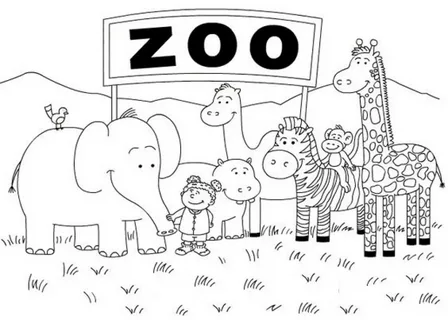Coloring zoo animal pages is not just a fun activity; it’s an excellent way to foster creativity, enhance motor skills, and learn about wildlife. While choosing colors is essential, using different coloring techniques can elevate your artwork from ordinary to extraordinary. In this blog post, we’ll explore some creative techniques to make your zoo animal coloring pages stand out.
1. Layering Colors
Layering is a technique that involves applying multiple colors in layers to create depth and dimension.
How to Do It:
- Start with a base color and apply it lightly across the area you want to color.
- Gradually add darker shades to the areas where shadows would naturally fall.
- Blend the colors together using a blending tool or a cotton swab for a smooth transition.
Benefits:
This technique can make Zoo Coloring Pages appear more realistic, showcasing their natural fur patterns or skin textures.
2. Blending with Markers
Using markers can produce vibrant results, and blending techniques can create stunning effects.
How to Do It:
- Choose two or more markers in similar color families.
- Color a section with the lighter color first.
- While the ink is still wet, use the darker color to add depth. Blend them together using circular motions.
Benefits:
This technique allows for smooth transitions and bright, bold colors, making your zoo animals pop off the page.
https://in.pinterest.com/pin/965177763887317655/
3. Watercolor Effect
If you’re using colored pencils or water-based markers, you can achieve a beautiful watercolor effect.
How to Do It:
- Color your animal using water-based markers or colored pencils.
- Once finished, lightly brush over the colored areas with a wet paintbrush or a damp sponge.
- Let the colors blend and dry naturally for a soft, flowing look.
Benefits:
The watercolor effect can create a dreamy atmosphere and give your coloring pages an artistic flair.
4. Using Patterns and Textures
Adding patterns or textures can make your coloring pages unique and visually interesting.
How to Do It:
- Experiment with different patterns like stripes, polka dots, or zigzags on your animals.
- Use colored pencils or fine-tip markers to create intricate designs within the animal shapes.
- You can even use stencils to add textures.
Benefits:
This technique allows for personalization and creativity, making your animals truly one of a kind.
5. Coloring with Pastels
Pastels can add a soft and subtle touch to your zoo animal pages.
How to Do It:
- Choose soft pastels or chalk pastels for your coloring.
- Apply the pastel lightly and blend using your fingers or a blending stump.
- For added depth, use a darker pastel for shadows and a white pastel for highlights.
Benefits:
Pastels can create a gentle, ethereal look, perfect for showcasing the beauty of animals.
6. Incorporating Backgrounds
Don’t forget about the backgrounds! Adding a colorful background can enhance the overall look of your zoo scene.
How to Do It:
- Choose colors that complement your animal colors.
- Create simple backgrounds like grass, trees, or a sky. Use gradient techniques to add depth.
- You can also incorporate patterns in the background to tie the whole page together.
Benefits:
A well-designed background can make your zoo animal stand out and create a cohesive scene.
7. Using Metallic or Glitter Colors
Adding a touch of metallic or glitter colors can add excitement and dimension to your coloring pages.
How to Do It:
- Use metallic gel pens or glitter markers to outline your animals or add highlights.
- Focus on areas like the eyes, accessories, or patterns to make them shine.
Benefits:
These techniques can make your coloring page eye-catching and vibrant, perfect for showcasing special features of the animals.
8. Mixed Media Techniques
Combine different coloring mediums for a dynamic look.
How to Do It:
- Start with colored pencils for detailed areas.
- Use markers for larger sections and pastels for backgrounds.
- You can even add stickers, washi tape, or cut-outs to enhance the visual appeal.
Benefits:
Mixed media techniques encourage experimentation and can lead to unique and personalized artwork.
Conclusion
Coloring zoo animal pages can be an enjoyable and creative experience, especially when you incorporate various techniques. Whether you choose layering, blending, or mixed media, each method brings a unique flair to your artwork. So gather your coloring supplies, explore these techniques, and let your imagination run wild as you bring your favorite zoo animals to life

